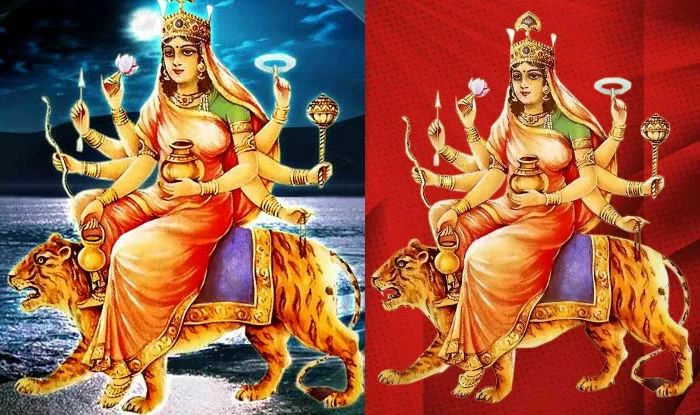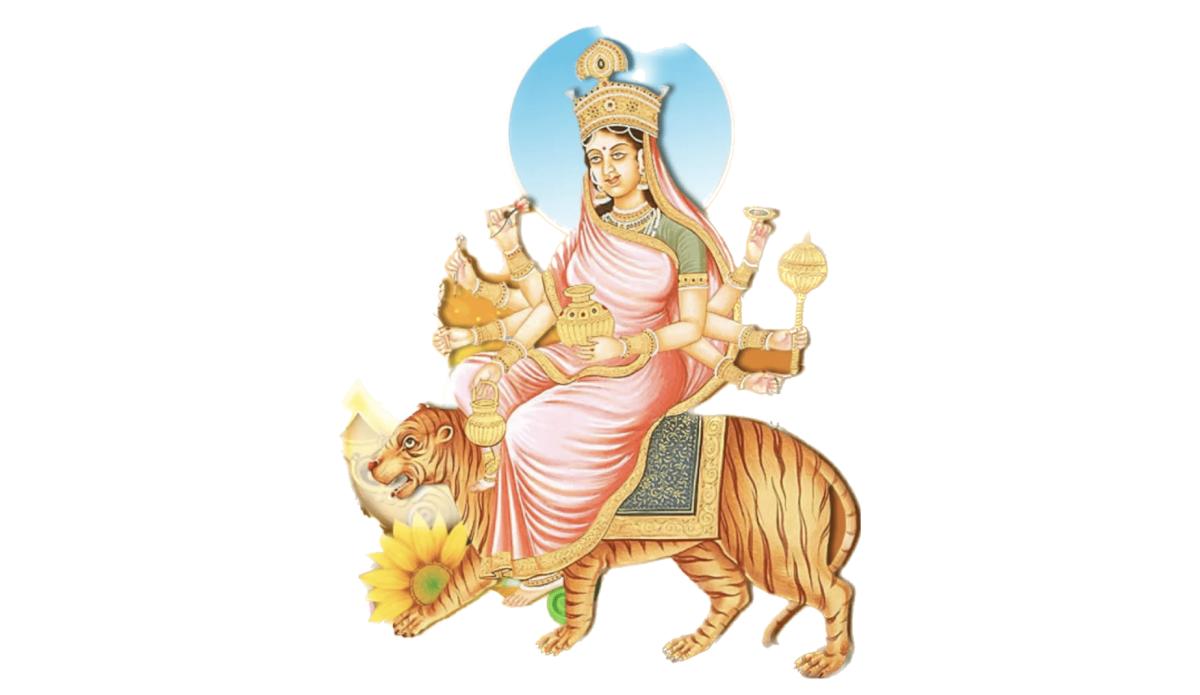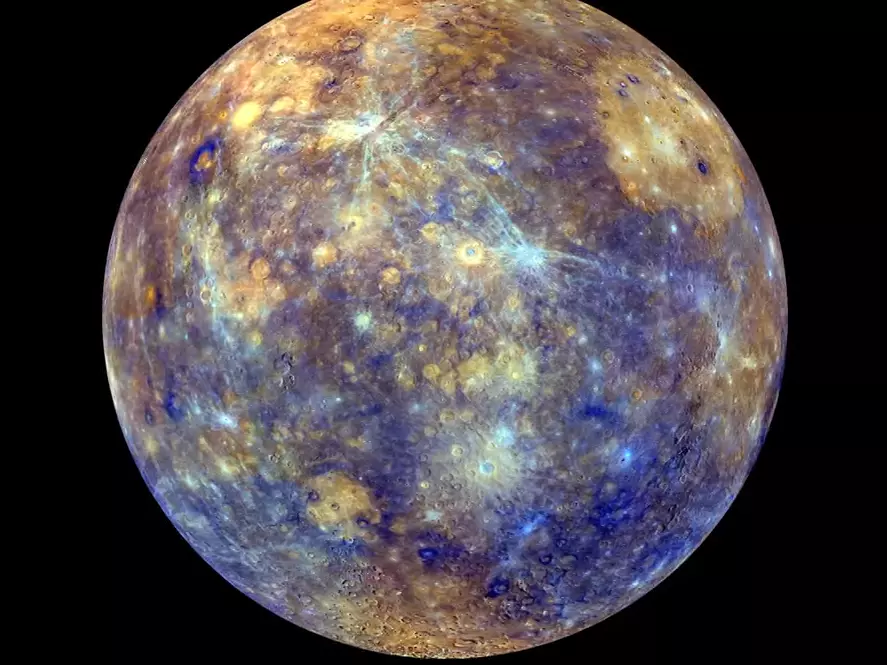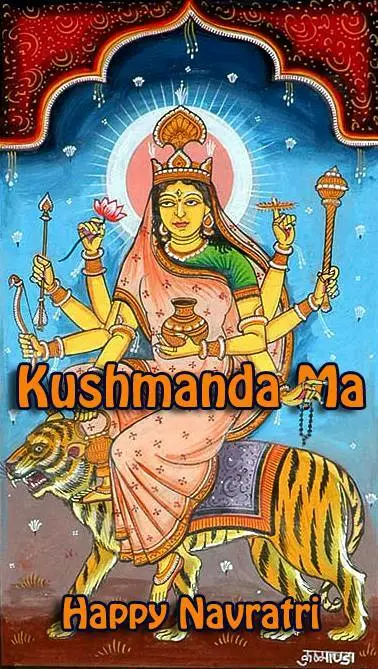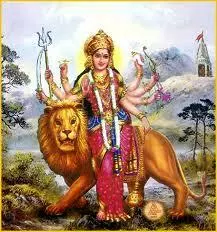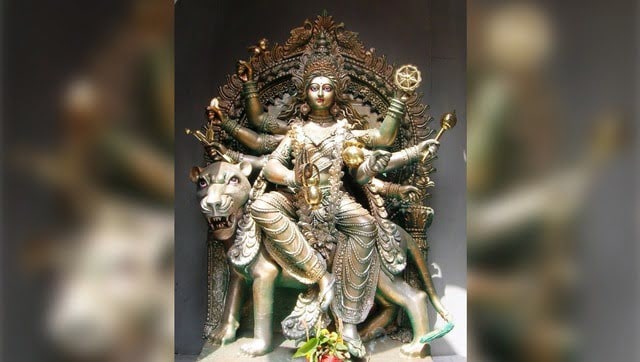#happy #Navratri Day 4
Chaturthi
#Maa #Kushmanda Puja
25th
March 2023
(Saturday)
Kushmanda Mata is worshipped on the fourth day of Navratri. Kushmanda is a Sanskrit name, which means: ‘Ku’ - small/little, ‘Ushma’ - energy/heat, ‘Anda’ - egg. This form of Goddess Parvati blesses her devotees with health, wealth, and strength.
About Kushmanda
Maa Kushmanda has 8 arms carrying Chakra (a weapon like discus), sword, Gada (mace), bow, arrow, Amrit Kalash (jar of the elixir of life), Kamandal (stoup), and lotus. Due to her 8 arms, she is also known as Ashtabhuja Devi. She rides a lioness.
Legend
When there was no universe and darkness was prevailing everywhere, Goddess Kushmanda brought light to the universe by producing the cosmic egg with a smile. She is the Goddess who can reside inside the core of the Sun. Her light and glow is just like Surya (the Sun).
When the universe got created, the Goddess created the Trideva (3 gods - Brahma, Vishnu, Mahesh) and Tridevi (3 goddesses - Kali, Lakshmi, Saraswati). She is the creator of the entire Brahmand (universe).
Astrological Aspect
Kushmanda Maa gives direction to the Sun. Hence, worshipping her can eliminate all the ill effects of the astrological planet Sun.
Mantras
ॐ देवी कूष्माण्डायै नमः॥
Prarthana Mantra:
सुरासम्पूर्ण कलशं रुधिराप्लुतमेव च।
दधाना हस्तपद्माभ्यां कूष्माण्डा शुभदास्तु मे॥
Stuti:
या देवी सर्वभूतेषु माँ कूष्माण्डा रूपेण संस्थिता।
नमस्तस्यै नमस्तस्यै नमस्तस्यै नमो नमः॥
Dhyana Mantra:
वन्दे वाञ्छित कामार्थे चन्द्रार्धकृतशेखराम्।
सिंहरूढ़ा अष्टभुजा कूष्माण्डा यशस्विनीम्॥
भास्वर भानु निभाम् अनाहत स्थिताम् चतुर्थ दुर्गा त्रिनेत्राम्।
कमण्डलु, चाप, बाण, पद्म, सुधाकलश, चक्र, गदा, जपवटीधराम्॥
पटाम्बर परिधानां कमनीयां मृदुहास्या नानालङ्कार भूषिताम्।
मञ्जीर, हार, केयूर, किङ्किणि, रत्नकुण्डल, मण्डिताम्॥
प्रफुल्ल वदनांचारू चिबुकां कान्त कपोलाम् तुगम् कुचाम्।
कोमलाङ्गी स्मेरमुखी श्रीकंटि निम्ननाभि नितम्बनीम्॥
Stotra:
दुर्गतिनाशिनी त्वंहि दरिद्रादि विनाशनीम्।
जयंदा धनदा कूष्माण्डे प्रणमाम्यहम्॥
जगतमाता जगतकत्री जगदाधार रूपणीम्।
चराचरेश्वरी कूष्माण्डे प्रणमाम्यहम्॥
त्रैलोक्यसुन्दरी त्वंहि दुःख शोक निवारिणीम्।
परमानन्दमयी, कूष्माण्डे प्रणमाम्यहम्॥
Kavacha Mantra:
हंसरै में शिर पातु कूष्माण्डे भवनाशिनीम्।
हसलकरीं नेत्रेच, हसरौश्च ललाटकम्॥
कौमारी पातु सर्वगात्रे, वाराही उत्तरे तथा,
पूर्वे पातु वैष्णवी इन्द्राणी दक्षिणे मम।
दिग्विदिक्षु सर्वत्रेव कूं बीजम् सर्वदावतु॥
With this, we hope that you will make the best of Navratri’s fourth day. May Maa Kushmanda blesses you with all the goodness of life.
Happy Navratri!
The colour of Day 4 of Navratri is royal blue. The colour signifies good health and prosperity. On this day, Goddess Kushmanda is worshipped. Goddess Kushmanda has eight hands and thus is also known as Ashtabhuja Devi.
The Fourth Night of #NavRatri is dedicated to Ma as Kushmanda – which I have figuratively chosen to render as ‘the Power of the Sun’.
In essence, the reason that the Sun is … well … the Sun – rather than some abstract ‘ball of flaming gas’, or even simply an inanimate, lifeless object, is due to Her. This applies also to the universe entire as a fairly directly consequent result, for reasons that ought prove readily apparent. Everything has its Shakti – and in this case, She truly is the Shakti of Everything.
It would be tempting to simply approach Her as a further expression of that enduring Indo-European understanding: the Solar Goddess (which, despite the prominence of a rather specific late-Classical perspective insistently ‘colonizing’ everybody’s perceptions, appears to be a much more pervasive and archaic element than Goddess(es) being only found amidst the Moon … often a Male figure, as it happens – not that you’d notice just going by the Classical comparanda). Except this would leave unexplored and underexpressed Her true saliency. Which is, I would say, eminently more profound and foundational to our world than even the Solar radiance presently rising into our sky.
And besides, it would be rather incomplete of us not to address the situation of this (essence of) Devi with relation to Lord Surya. A male Solar deific, yes (although it must be emphasized, as I often do, that there has usually not really been one Sun per Indo-European pantheonic setup – rather the Sun is more of a ‘position’ that, depending upon context, various figures may ‘step into’ as required … or may be an inanimate object, even) – and not at all contradictory with having a female Solar deific also. Indeed, the Two must actively work in tandem.
Behind every Radiant Man … there is, indeed, an eminently Empowering Woman.
So … let us look at Her Name. As I am a great believer that via understanding and grasping the name, the etymology, the mytholinguistics of a figure … we gain great and otherwise-hard-to-come-by insight as to Their true nature.
Names do, indeed, not only ‘reference’ but also ‘encapsulate’ Being, as we shall soon see in macro!
Kushmanda, however, defies easy conceptualization in such a regard. ‘The Power of the Sun’ is, I believe, an accurate ‘essence’ – yet it is not truly what the words involved literally mean. They are more evocatively expressive than that. And contain within them Multitudes in terms of what is actually meant, entailed, and what links up with what elsewhere within its appropriate, attendant mythic sphere and context. Fanon’s point about speaking upholding the weight of a civilization even through the minutiae of words and other such formulations seems apt for the intricacies of interleavened resonancy here.
A more direct translation is usually given as something along the lines of “a little (Ku) warmth (Ushma)” in relation to a certain Egg (Anda).
However this I consider to be … somewhat inaccurate – and, indeed, there seem to be quite a few attempted translations or unpackings of ‘Kushmanda’ out there even amidst Hindu commentaries that seem to leave a bit to be desired.
So, let us start from the bottom. ‘Ku’ ( कु ) – while it can be applied as a diminutive, also tends to have an array of connotations that should make it rather curious in this context.
As it’s not so much “little” as it is “meagre”, “mean”, “insufficient”, “inferior”, or even outright false and negative.
That is not something which fits with the Goddess or Her cosmological role – it should certainly prove a most curious manner to address the Solar Power Herself !
Two other ‘Ku’ renditions are perhaps more immediately salient for us here.
The first of these concerns ‘Ku’ as a ‘base’ or the ‘Earth’. A foundation, we might suggest.
The second, is a Sound – likely a rather indistinct sound that we are not quite able to grasp the meaning of as a language.
Experienced followers of my work shall instantly apprehend where we’re going with this …
The ‘Ushma’ (उष्म) particle being understood as ‘Warmth’ is, again, not inaccurate – although may be somewhat incomplete.
For in addition to ‘Heat’, there is also a cheerful ‘Summer’ sense to it – and, of course, ‘Fire’.
We might figuratively compare ‘Tapas’, for reasons that we shall address later on.
‘Anda’, as Egg, has at least three not-necessarily-exclusive interpretations we could foster.
The first and most obvious being the Egg at the beginning of everything;
The second, a more generalized connotation of fertility and generative fostering for the necessary fundaments of life in this universe of ours – in a more ongoing sense than that Cosmic Egg, I mean;
And the third, the Sun – an ‘Egg’, or a ‘Source of Life’, that is, we might figuratively suggest .. ‘Sunny Side Up’.
Except there is another possibility … that of the final component to ‘Kushmanda’ in fact being ‘Da’ ( ड ) – which, once again, connotes ‘Sound’ (particularly that of a rhythmic beat) – and potentially the drum that makes it; or a basket or carrying device, an epithet of Shiva, a Bird, or ‘Submarine Fire’. There is also some suggestion that, in fact, the particle is ‘Daa’ ( डा ) – which would pertain to a Dakini.
All of these are relevant.
How?
Well consider what we have here. Kushmanda is stated in the theology to be just as we have said in our introduction: The Power of the Sun. The Shakti of the Universe – the ultimate source and (Solar) empowerer of Life within this most expansive sphere of ours.
We have long observed that there is a remarkable mytholinguistic pattern in the Indo-European languages for a ‘Solar Speech’ coterminity – words for Sounding, for Speech, being correlate with terms for Illumination, Light.
The best example of which would be terms derived from the two Proto-Indo-European *bʰeh₂ roots – the one that means ‘illumination’, and the one that pertains to ‘communication’.
We considered quite an extensive array of these in our previous piece, imaginatively entitled – “On The Mytholinguistics Of The Solar Speech”. We shall not endeavour to seek to repeat that work here.
https://aryaakasha.com/2022/01/09/on-the-mytholinguistics-of-the-solar-speech/
However, there is another dimension to proceedings. Two, in fact. Three, if we really think about it.
The first – and it is literally the first – concerns the Sound at the Start of Everything.
To quote me some Terry Pratchett [from one of his earlier works – ‘The Light Fantastic’] –
“There was a rustling in the darkness.
‘In the beginning was the word,’ said a dry voice right behind him.
‘It was the Egg,’ corrected another voice. ‘I distinctly remember. The Great Egg of the Universe. Slightly rubbery.’
‘You’re both wrong, in fact. I’m sure it was the primordial slime.’
A voice by Rincewind’s knee said: ‘No, that came afterwards. There was firmament first. Lots of firmament. Rather sticky, like candyfloss. Very syrupy, in fact—.’
‘In case anyone’s interested,’ said a crackly voice on Rincewind’s left, ‘you’re all wrong. In the beginning was the Clearing of the Throat—’
‘—then the word—'”
Now, this is a work of satire that is briefly name-checking a few prominent cosmogonical perspectives encountered in various of the religions of the world.
Any Christian shall recognize “In the beginning was the Word”; the “Egg”, we have earlier met as one of the (various) Hindu perspectives – and we can find … well, ‘primordial slime’ we might have to get a bit creative with. Certainly The Waters are somewhat relevant here.
But it is this ‘Clearing of the Throat’ that has caught my imagination herein. For you see – what we find at the absolute beginning of everything is not a ‘Word’ in the sense that should prove intelligible to us. Indeed, it may not even be the Speaker that many are used to thinking of in such a capacity – Vishvakarman etc. as a ‘Solar Smith’, a Priest Who Speaks the world into being (c.f my work on Svarog). But rather, there is the ‘getting ready’ for that Voice to take flight.
We might say that this is the ‘Cracking’ of that Cosmic Egg aforesaid. A noise like Thunder. And, to quote myself upon the subject:
“‘Crack’ and Garjati – the latter meaning a roar, or a low-frequency humming, a growl, a resounding noise, the sound of the Thunder – actually share an etymological root in PIE *gerh₂- .”
Why is that salient?
Due to one of my favourite Sanskrit theological maxims (and this is the part I was directly foreshadowing when I had earlier suggested that: “Experienced followers of my work shall instantly apprehend where we’re going with this …”).
Vacam Garjit Lakshanam. What does it mean? Vacam – ‘(Divine) Voice’ or (Sacred) Speech (and implicitly the Devi thereof); Garjit – ‘Thunder’, or an ‘Indistinct Noise’, a ‘Roar’; Lakshanam – ‘Bearing the Imprintings of’, ‘Having the Characteristics of’.
Thunder bearing the imprinting of Divine Speech. Or, and this is an important figurative sense that actually underpins much of the concept … it is an incredible noise that we can’t necessarily understand. We don’t, after all, hear the Words in Thunder – we just hear it. Even if it can fairly be argued that Thunder is fundamentally ‘communicative’ – usually of the fact that somewhere, it is raining. So … ‘indistinct speech’ (to our (mortal) ears) that nevertheless contains the ‘Seed’ of All. ‘Aum’, perhaps we might suggest …
However, this notion of ‘Cracking’ is also pertinent in another fashion as well. One visual rather than sonorous. For you see, the mythology around Kushmanda has Her ‘cracking a Smile’. Indeed, it is this act that begins the emanation of Holy Light into our cosmos. She must most certainly have impressive Teeth!
So that, then, is this first sense that is pertinent here. The ‘Big Bang’ of the Cosmic Drum – that ‘first strike’ which sets it all into motion; making the way and opening the floor for the First Singer to begin the Cosmic Performance in earnest.
The second sense concerns ‘what came next’ – both in one sense, immediately following the above; and in another sense, enduringly following the above. That is to say .. it is not merely ‘step two’ to the Universe’s unfolding – it is something that is ongoing as a continual re-immanentization of this even right down to this very Day.
On one level, we have already covered this. The Universe is made up of Sound. Cosmic Speech – Divine Speech. Words. Hence the plenipotentiary status of Vak Devi. She is an in-universe (Active) Expression of Rta, Brahman. As we would understand it in the Shakta sphere – The Goddess That Is Über Alles and A-Priori to Everything, emanating Herself into this cosmos – also as the Cosmos. All-pervading and giving qualities to all via Her most mystical potency of Words, and their hard-embedded mytholinguistic conceptry. Names, as we all know, have such potency to them – if you know and can understand the true ones.
The Word may indeed not quite be In The Beginning, precisely because what is first and foremost required is a Mouth with which to Express Them (and there is some rather intriguing conceptry for the Tongue within said Mouth that we have previously explored and elocuted with particular deference to Sarpa Rajni (The Queen of Serpents) and Sarasvati (‘Pure Speech’, indeed), and other such conceptual representations which we might so happen to taste (with) from time to time). And even a-priori to that is the requisite Mind, Spirit, with which to have the Thought (or, if you like, Dream – Vision) to thence turn into the Speech. But we are … getting a bit heady now, so back to the major pillar of our (Sacral) post.
As we have so often observed, the Ritual Space of the Indo-European in the archaic world is a ‘microcosm’ of the Universe (the ‘macrocosm’) – indeed, as Robert Levy most usefully observed, it is in fact a ‘Mesocosm’ – a space poised between the ‘microcosm’ and ‘macrocosm’ where the one can engage and more saliently ‘influence’ or ‘co-express’ with the other. But more upon that elsewhere.
At the heart of such a space, what do we find. Often it is a Post – an Axis Mundi resonancy. The ShivLing we have shown to be just such a thing – the Irminsul of the Germanics, no doubt, likewise. And we of course have the ‘Omphalos’ conceptry known amidst the Greeks.
However we also tend to find the Fire – the ‘Live Fire’, the ‘Sacral Flame’, into which offerings may be offered so that they make their way to the Gods.
Now this is often thought of as being Agni’s demesne-domain. And that is not wrong. Only ‘incomplete’.
For you see – we know via Hestia of the Greeks that the Indo-Europeans also conceived of the Sacral Fire as having a Goddess living within it. Scythian Tabiti (there’s that ‘Tapas’ cognate) is equated with Hestia in a sense by Herodotus – and we believe he was most eminently not wrong to do so. It is only that Hestia had become somewhat ‘reduced’ in comparison to Her no doubt more imperious situation in the archaic days of the Proto-Indo-European Urheimat. We see this trend persisting even today – where a Goddess Whom in Classical times one might find as the Fire at the heart of the Polis (and, we would suggest, the Universe Itself) … has been reduced in the popular imagination to something of a Goddess of Cooking Fires. Quite literally consinged to “get back to the kitchen”. A situation aided by just how much we have forgotten about – well, the centrality of Hearth to making a Home and its liveable situation.
The innate integrality of Hestia to the cosmos (and here I am meaning it in the archaic Greek sense – the ‘regime’, the ‘Divine Realm’ and ‘Rule’) is aptly demonstrated via the relevant Orphic Hymnal unto Her:
“Daughter of Kronos, venerable dame,
Who dwellest amidst great fire’s eternal flame;
In sacred rites these ministers are Thine,
Mystics much blessed, holy and divine.
In Thee the Gods have fixed Their dwelling place,
Strong, stable basis of the mortal race.
Eternal, much formed, ever florid queen,
Laughing and blessed, and of lovely mien;
Accept these rites, accord each just desire,
And gentle health and needful good inspire.”
[Taylor translation]
And, because sometimes people look a bit sideways at the Orphic corpus – from Homeric Hymnal 29″
“Hestia, in the high dwellings of All, both deathless Gods and men who walk on earth, You have gained an everlasting abode and highest honor: glorious is Your portion and Your right.
For without You mortals hold no banquet, – where one does not duly pour sweet wine in offering to Hestia both first and last.”
[Evelyn-White translation]
But what does all of this have to do with the Vedic sphere? And, more pointedly, Shakta theology?
Well … contrary to what you may have heard, the Shakta theology is strongly founded within the Vedic – indeed, due to the intrinsic role of Vak, we might even suggest that it is the case that the Vedic theology is strongly founded within the Shakta. Certainly, it is actively expressive of the Shakti !
Within the ritual manuals of the Shatapatha Brahmana, we observe several vitally interesting expressions of just such an understanding as we are getting at here with Kushmanda.
We shall quote a verse to elucidate:
“9 Now as to why he pours ghee on the high altar, while the fire is held (over it). Because the Gods said to Her [Vak] on that occasion, ‘The offering shall reach Thee before Agni,’ therefore the offering now does reach Her before (it reaches) Agni.
And because She said to the Gods, ‘Whatsoever blessing Ye will invoke through Me, all that shall be accomplished unto You!’ therefore the priests now invoke through Her that blessing upon the sacrificer, and it is fully accomplished unto him.”
[SBr III 5 2, Eggeling translation]
However, we can go further.
“23 And, accordingly, when he [the sacrificer / ritualist] pours ghee on the high altar, while the fire is held (over it)–
since the Gods said to Her on that occasion, ‘The offering shall reach Thee even before Agni’–then that offering does reach Her even before (it reaches) Agni; for this (high altar) is in reality Vâk. And when he raises the high altar, it is for the completeness of the sacrifice, for the sacrifice is Vâk (speech) and that (high altar) is Vâk.”
[SBr III 5 1, Eggeling translation]
As we had noted elsewhere and in previous – “It is also good to note the direct linkage of Vak with the ‘high altar’ of the rites under discussion – as this comports with the etymology for ‘Hestia’ : which directly comes from an Ancient Greek term for a fireplace, ‘Hearth’, or altar : ἑστίᾱ (‘Estia’).” We shall explain the purport of this momentarily. But let us go further still !
SBr III 2 1 sets out a most fascinating and vitally important metaphysics for the Vedic Yajna rite. What occurs therein is Vak is summonsed into the Altar-space – in order to bring the Fire to a certain sort of Life. And, flowing from there, to bring Life out of the Flames – as Vak is, after all, a Devi (indeed, The Devi), a Woman, and bears a most magnificent Child indeed.
In that context, it is Indra that is ‘birthed’ out of this process. And we must pay careful attention to what has gone on here. For it is a ‘microcosmic’ expression of a ‘macrocosmic’ principle. Although afore we get to that – in the ritual conceptry, what we are seeing is the ‘Invoking’ of the Great God, Indra, and causing Him to come down here amongst us in order to participate in the Rite. How does Indra make His way to us in this particular ritualine context? The same way that the offerings would ordinarily go up unto Him. Through the Flame. That Fire-Conduit at the heart of everything – in the ritual sphere, as in life. It is, after all, through Fire that we eat (the ‘Fire of the Belly’ in Hindu perception), and the column of Energy that connects all the centers of our earthy (and transcendental) existence within us likewise that presents quite the conduit for same.
Vak, here, in this ritual occurrence, is acting as a ‘Mother’ to Indra out into this world, this ‘microcosmic’ space – a ‘ritual understanding’, I do not mean to suggest merely a ‘ritual implement’, as She is most definitely Alive as an essence-tial essence to the mechanism. And quite capable of getting rather annoyed, wandering off, and/or turning into a fearsome, formidable Lioness if ‘objectified’ or maltreated. In the Macrocosmic space, we find Aditi as Mother of Indra – and Vak, as is quite extensively attested in the Vedas, is Aditi. Aditi being, as you all know, ‘The Limitless’, ‘The Infinite’, (‘The Absolute’?) and implicitly ‘Solar’ as well. Handy how it all fits together like that, isn’t it. (The Mat(t)er goes further with the commentary upon, for instance, SBr I 3 1 17 pertaining to Aditi being the (earthen) Altar likewise (the ‘base’ for the operation’s placement), as well).
Yet how does that pertain to our Cosmos and the salient supremacy for Kushmanda therein with (and through) same?
Well, the Fire at the heart of the ritual space – it is the ‘resonancy’ for the Sun at the center of our solar system, at the center of our mortal affairs. As somebody (I think it was Sadhguru but probably various other luminaries as well) once observed – pretty much all life upon this earth is, in essence, Solar Powered. We are all here because the Sun is (up) there.
This brings us back to our mytholinguistic and etymological ‘unpacking’ of Kushmanda – ‘Ku’ as in ‘Base’ or ‘Earth’, ‘Ushma’ as in the life-giving Solar quality (as particularly expressed through the abundance of Summer) … and that ‘Anda’ or ‘Da’ being renderable in quite a few ways to achieve ultimately similar impetus. The ‘Cosmic Egg’ in relation to ‘Sun’ we have previously aforementioned. The Sun’s life-giving rays as Sound, we can infer. The strong conceptual linkage in the Vedas for the Sun to a Bird, or to Fire coming up from the firmamental Waters is both well-known and eminently logical. Shiva as ‘Solar’ we can also directly attest (and where would He be without His Shakti – His Wife … ‘Disempowered’ or even actively ‘Remote’, the world – His World, at least – turning slowly into a ball of Ice akin to the peaked inhospitability of His high-Himalayan retreat when She is gone from Him during the period between Sati’s immolation upon the sacral pyre of Daksha and Her reincarnation as Shailaputri). The notion of the ‘Basket’ bringing these essential radiancies of life and nourishment? It should most certainly fit together likewise. And ‘Dakini’ – well, consider just exactly what a Dakini is actually supposed to be. A (female) figure in amidst the Sky, a bearer and active expression of Energy. A Drum or Drumbeat? The former is the Sun, the latter is the regulation of our world provided via the regular modulation of our experience of its rays – ‘Seasons’, ‘Horae’ (and note the potential etymological coterminity viz. ‘Hera’, as well!), ‘Hours’, and ‘the Year’ (PIE *yóh₁r̥ underpinning various of these). (It might also be tempting to speculate upon Proto-Slavic *jarъ and its various other ‘furious’ descendants in line with this as similarly expressive of this ‘life force’ and ‘order’, given the sustained mytholinguistic coterminity for the ‘furious’ senses of the descendant terms with the ‘year’ and ‘spring’ ones in certain languages – as well as the significant role for the Goddess in question in imparting not only Life but also Furor (‘Ugra’, per RV X 125 5, for instance; or the Menos & Menis potencies of the Iliad granted by Athena; etc.)… ; but more upon that, perhaps, at some other time).
However, I said that there would be a third potential sense to our Universal unfurling from the Mouth of Devi conceptry – and it is to that which we shall now turn.
Earlier, I suggested that the Universe was, in essence, Sound – Speech. I also related that the Ritual Space is a resonancy, an expression for the Universe – and vice versa, to a certain degree, anyway. Objects (or patterned inferency) ‘going up’ have a lot more inertia to overcome than those ‘coming down’.
We find a most intriguing ‘esonance’ for both of these principles when considering RV X 114 8 – an indelibly complex verse within a beautifully poised ‘allusive’ Hymn. We shall not seek to unpack its full purport here. But to briefly parse its meaning:
“sahasradhā pañcadaśāny ukthā yāvad dyāvāpṛthivī tāvad it tat |
sahasradhā mahimānaḥ sahasraṃ yāvad brahma viṣṭhitaṃ tāvatī vāk ||”
What does this mean?
Sahasradha – ‘a thousandfold’; panchadasany – ‘fifteen’; uktha – ‘prayers’, ‘hymns’ (uktha is from ‘Vak-Thak’ – the ‘expressed’ (Thak) Vak); yavad (yavat) – ‘as far as’, ‘co-extensive with’, ‘to the bounds of’, ‘as long as’, etc.; dyavaprithvi – ‘heaven and earth’ (i.e. ‘everywhere’); tavad – ‘so great’, ‘so expansive’, ‘so much’; it – ‘indeed’; tat – ‘that’.
Mahimanah – ‘Greatness’, ‘Glory’, ‘Majesty’, ‘Power’, ‘Might’; sahasram – ‘thousand’; brahma – here short for ‘brahman’, and meant in the older Vedic sense not necessarily as the Absolute, but rather ‘ritual formulation’, ‘prayer’, ‘hymnal’, ‘invocation’; visthitam – ‘standing’, ‘spreading’; Vak .. should by this point require no introduction!
So, now that we have the individual words … the purport should become more readily apparent. The verse is stating that the Universe is permeated by the Expressions of Vak. Whether in the sense of Words or Song in Prayer – or the ‘animating’ Devi that underpins each and all of these and renders these more than mere flapping of gums and expulsion of air and meaningless except as atmospherics. These are not merely ‘permeating’ of the Universe – but are ‘co-extensive’ with. And, as we can see, the bounds of the ritual operations area (the ritual space and sphere) are likewise … both coterminous with the Universe and also with Her.
There is more to it that can unquestionably be extracted, but it is enough for now.
The point is – the ‘animating principle’ of the Ritual Space is Vak.
The ‘animating principle’ of the Universe is also Vak (and we may direct one’s attention to RV X 125 – the famed DeviSuktam – for more upon this general and vitally important theme !)
The Universe Itself, Entire, is also a (macroscopic, macrocosmic) Ritual Sphere.
And what makes the Ritual Sphere? Why, the very same thing that makes a ‘House’ into a ‘Home’ per our Ancient Greek influenced development … or, rather, I should say our Proto-Indo-European mytholinguistic-originated conceptry.
‘Hestia’ is, we surmise, from PIE h₂wes- (‘to dwell’, ‘to spend the night’), which, via PIE *h₂wéseti (the suffix being a ‘thematic’), gives us Sanskrit ‘Vasati’ – a term, indeed, for a Dwelling, a House; and via PIE *h₂wóstu (which underpins .. an array of other such terms in other IE languages), it produces ‘Vastu’ … a term that is rather ‘foundational’ to the conception of ‘Home’. And, from this latter, ‘Vastospati’ – ‘Protector of the Home (& Hearth)’, an epithet used with intriguing prominence for Rudra in the RigVeda etc.
There is some further intriguing resonancy viz. terminology for ‘Essence’ and *its housing, which we do not think is at all coincidental. But we should, perhaps get into that at some other point in time.
Our Universe, as with the conceptual ‘space’ that must surely underpin the above-mentioned, becomes ‘habitable’ in just the same fashion. Through Her – investing and empowering, emanating, carrying, speaking, and above all Smiling.
May we always come back to this Source when we so need, no matter how far we might wander in the intervening interim.
Hunter S. Thompson, in Fear and Loathing in Las Vegas, put it thusly – “Well, I thought. This is how the world works. All energy flows according to the whims of the Great Magnet. What a fool I was to defy him. He knew. He knew all along. […] Never cross the Great Magnet. I understood this now . . . “
He got this completely right. Except for the gender.
ॐ देवी कूष्माण्डायै नम
जय माता दी
https://aryaakasha.com/2022/04/05/kushmanda-for-chaitra-navratri-the-power-of-the-sun/
